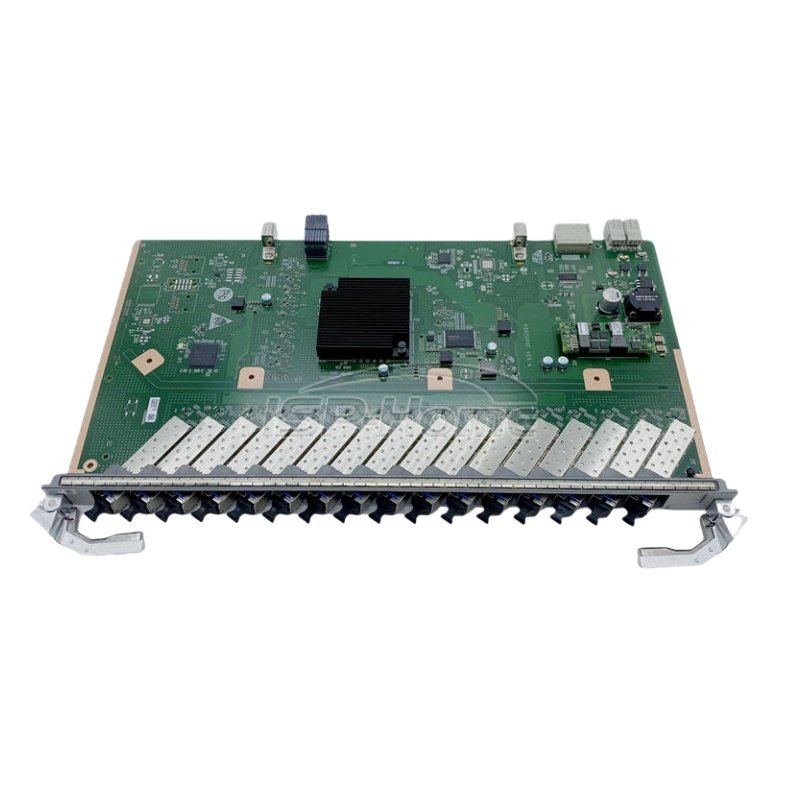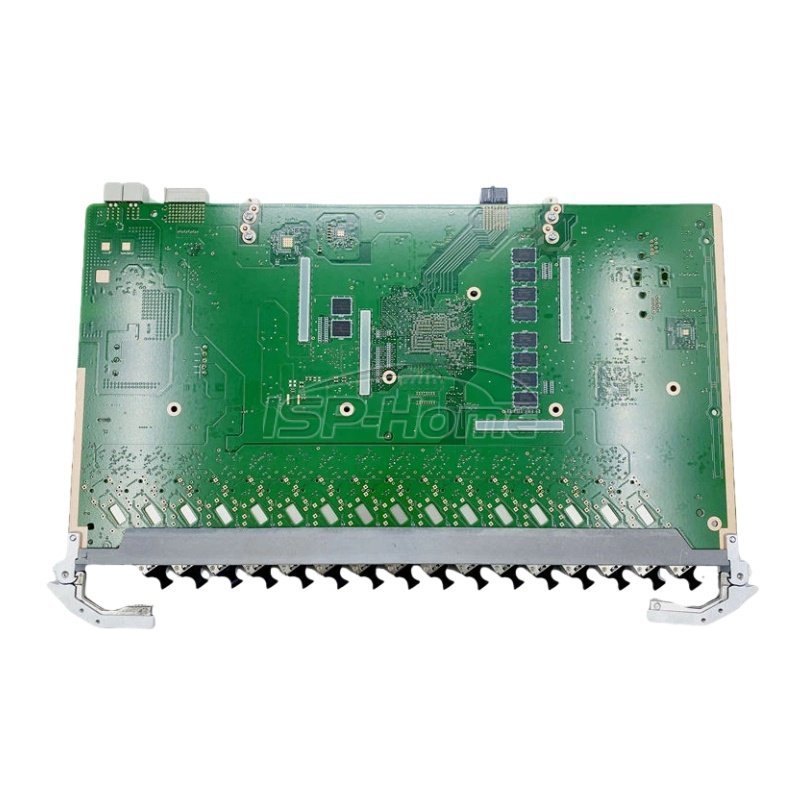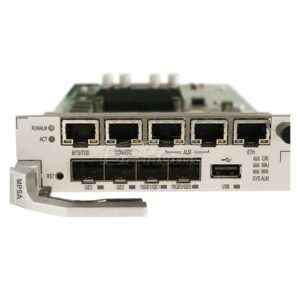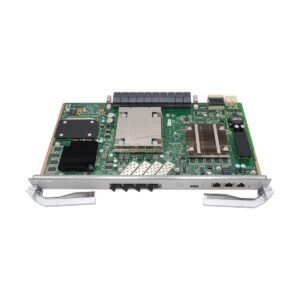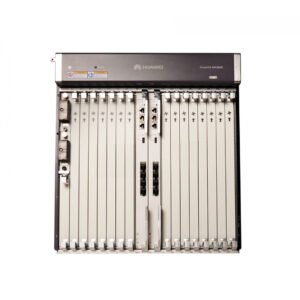Description
The Huawei GPLF is a 16-port GPON OLT interface board designed for the MA5800 series OLT (including MA5800-X2, MA5800-X7, MA5800-X15, and MA5800-X17 models). It supports B+, C+ , C++ class SFP optical modules and achieves a maximum split ratio of 1:128 per port, enabling FTTH connectivity for up to 2048 subscribers.
Key Specifications
Huawei 16-GPON Port Interface Card
Apply to Huawei MA5800 X2, X7, X15, X17 NG OLT system
Support split ration 1:128
Transmit Speed: 2.488Gbit/s, Receive Speed: 1.244Gbit/s
Interface Type: SC
Max Transmit Distance: 20KM
Transmit Wavelength: 1490nm
Receive Wavelength: 1310nm
Standards Compliance: ITU-T G.984.1, ITU-T G.984.2, ITU-T G.984.3, ITU-T G.984.4
C+ SFP Module Optical Power: 3 dBm~7 dBm, Receiver Sensitivity: -32 dBm
H901GPLF Specification
| Specification | |
|---|---|
| Service ports | |
| GPON Port | 16-GPON Port |
| GPON SFP Module Specification | |
| Type | C+ Module : One-fiber bi-directional optical module, class C+ |
| Operating Wavelength | Tx: 1490 nm, Rx: 1310 nm |
| Encapsulation Type | SFP |
| Port Rate | Tx: 2.49 Gbit/s, Rx: 1.24 Gbit/s |
| Minimum Output Optical Power | C+ Module : 3.00 dBm |
| Maximum Output Optical Power | C+ Module : 7.00 dBm |
| Maximum Receiver Sensitivity | C+ Module : -32.00 dBm |
| Optical Connector Type | SC/PC |
| Optical Fiber Type | Single-mode |
| Reach | 20.00 km |
| Overload Optical Power | C+ Module : -12.0 dBm |
| Extinction Ratio | 8.2 dB |
| Device Specifications | |
|---|---|
| Dimensions (W × D × H) | 23.30 mm × 257.90 mm × 399.20 mm |
| Power Consumption and Maximum Frame Size | |
| Power Consumption | Static: 25W; Maximum: 50W |
| Maximum Frame Size | 2052 bytes |
| Operating temperature | -40°C to +65°C |
FAQ
Q: What’s the difference between GPHF, GPUF, GPLF, GPSF?
A:
| Specification | GPHF | GPUF | GPLF | GPSF |
|---|---|---|---|---|
| Application scenario | FTTC/B/D, D-CCAP, FTTH, FTT0/FTTM | FTTC/B/D, FTTH, FTTO/FTTM | FTTC/B/D, FTTH, FTTO/FTTM | FTTH |
| Port Qty | 16 | 16 | 16 | 16 |
| Forwarding capability | 40 Gbit/s
| 40 Gbit/s | 40 Gbit/s | 40 Gbit/s |
| Port rate | upstream: 1.244 Gbit/s downstream: 2.488 Gbit/s | |||
| Max split ratio | 1:128 | 1:128 | 1:128 | 1:128 |
| Controlled optical signal transmission of the optical module | Yes | Yes | Yes | Yes |
| ONU-based shaping | Yes | Yes | Yes | Yes |
| Temperature query and high temperature alarm | Yes | Yes | Yes | Yes |
| Automatic power shutdown in case of a high temperature | Yes | Yes | Yes | Yes |
| Energy saving for service boards | Yes | Yes | No | Yes |
| Max distance difference between two ONUs under the same PON port | 40km | 40km | 40km | 40km |
| Max number of MAC addresses | 131072 | 32768 | 32768 | 16384 |
| Board supporting downstream FEC | Yes | Yes | Yes | Yes |
| Board supporting upstream FEC | Yes | Yes | Yes | Yes |
| Rogue ONT detection and isolation | Yes | Yes | Yes | Yes |
| Assured bandwidth configurable on a port | 1238784 kbit/s | 1238784 kbit/s | 1238784 kbit/s | 1238784 kbit/s |
| Number of T-CONT supported by each GPON port | 1024 | 1024 | 1024 | 1024 |
| Number of ONUs supported by a GPON port | 128 | 128 | 128 | 128 |
| Number of GEM ports supported by each board | 16384 | 16384 | 16384 | 16384 |
| Number of GEM ports supported by each GPON port | 3872 | 3872 | 3872 | 3872 |
| MAX Number of Service Flows Supported by the Board | 16368 | 16368 | 16368 | 16368 |
| 9K Jumbo frames | Yes | No | Yes | No |
| Routes/ARP | 196608 | 196608 | 196608 | 65536 |
| 1588v2 | Yes | Yes | Yes | No |
| NTP | Yes | Yes | Yes | Yes |
| HQoS | Yes | No | No | No |
| Security (Anti-DOS, Anti-MAC/IP Spoofing) | Yes | Yes | Yes | Yes |
| Y.1731 PM | Yes | Yes | Yes | Yes |
| PON ISSU | Yes | No | No | No |
| D-CCAP | Yes | No | No | No |
| GPON Type B Protection Principles (Single Homing) | Yes | Yes | Yes | Yes |
| GPON Type B Protection Principles (Dual Homing) | Yes | No | No | No |
| GPON Type C Protection Principles (Single Homing) | Yes | Yes | Yes | Yes |
| GPON Type C Protection Principles (Dual Homing) | Yes | No | No | No |
| Power budget supported by a GPON port | Class B+ (28.5 dB, mostly used), Class C+ (32 dB, longreach transmission), Class C++: 35 dB | |||
| Minimum bandwidth supported by a T-CONT | 1 Mbit/s (in the minimum delay mode), 128 kbit/s (in the maximum bandwidth usage mode) | |||
In summary:
1, GPHF is better performance than the other 3 boards, and have more functions and application scenario supported;
2, Only GPFD supports HQoS, PON ISSU and D-CCAP;
3, GPUF and GPSF do not support 9K Jumbo frames.
Q: What are the specifications of the GPHF GPON optical module?
| Parameter | Class B+ Module | Class C+ Module | Class C++ Module |
|---|---|---|---|
| Serial Number | 1 | 2 | 3 |
| Operating Wavelength (Tx) | 1490 nm | 1490 nm | 1490 nm |
| Operating Wavelength (Rx) | 1310 nm | 1310 nm | 1310 nm |
| Encapsulation Mode | SFP | SFP | SFP |
| Bandwidth (Tx) | 2.488 Gbit/s | 2.488 Gbit/s | 2.488 Gbit/s |
| Bandwidth (Rx) | 1.244 Gbit/s | 1.244 Gbit/s | 1.244 Gbit/s |
| Minimum Output Optical Power | 1.5 dBm | 3.0 dBm | 6.0 dBm |
| Maximum Output Optical Power | 5.0 dBm | 7.0 dBm | 10.0 dBm |
| Maximum Receiver Sensitivity | -28.0 dBm | -32.0 dBm | -35.0 dBm |
| Optical Connector Type | SC | SC | SC |
| Optical Fiber Type | Single Mode | Single Mode | Single Mode |
| Saturation Optical Power | -8.0 dBm | -12.0 dBm | -15.0 dBm |
| Extinction Ratio | 8.2 dB | 8.2 dB | 8.2 dB |

